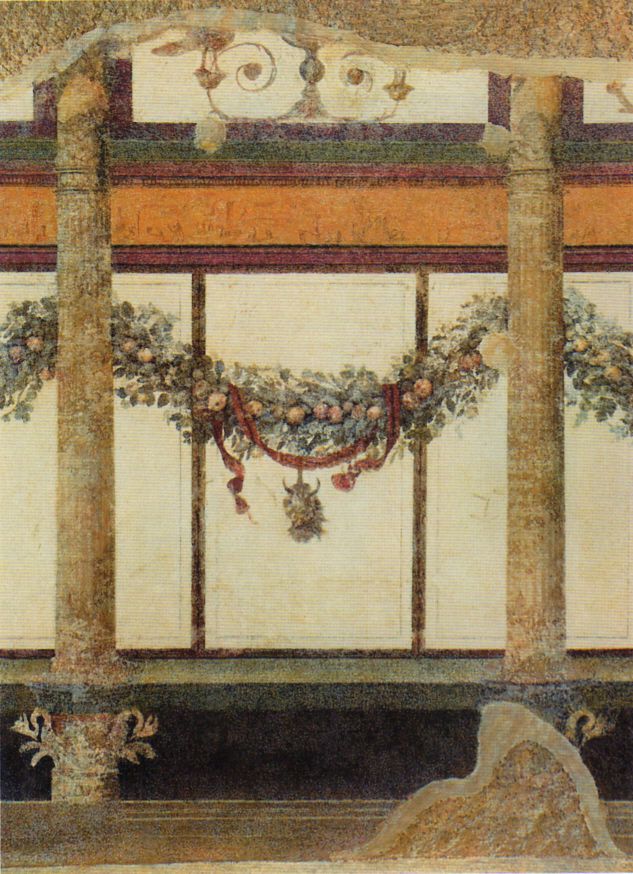Four Styles Of Roman Wall Painting

The Pompeian Styles are four periods which are distinguished in ancient Roman mural painting.They were originally delineated and described by the German archaeologist August Mau, 1840–1909, from the excavation of wall paintings at Pompeii, which is one of the largest group of surviving examples of Roman frescoes.. The wall painting styles have allowed art historians to delineate the various.
Four styles of roman wall painting. Roman wall painting styles Painted Garden, Villa of Livia Still Life with Peaches House of the Vettii Villa of Mysteries Republic. And it is thanks to August Mau, a nineteenth-century German scholar, that we have a classification of four styles of Pompeian wall painting. View of Mount Vesuvius from Pompeii. While Roman painters used several methods for painting the walls of large homes, the fresco method, which involves painting the wall while the plaster is still wet, is among the most recognized today. Roman frescoes use vibrant colors to depict images of family members, scenery from Roman mythology or outdoor scenes that have only decorative value. The wealth of surviving examples at sites such as Pompeii and Herculaneum has allowed Roman wall painting to be classified into four different styles. In Style I, which became popular from the early 2nd century BCE, the wall was typically painted with a dado, a middle space often divided into three areas and a frieze and cornice as in Classical. The first scholar to classify the Pompeian painting was the German archaeologist August Mau that stood out in four styles.. The first style, referring to the period from III to I century BC, of Greek origin, structural style or fouling, was an imitation stucco, often in relief, the technique called opus quadratum, used to coat the marbles exterior walls of public buildings and religious in the.
Roman wall painting was divided into four different styles, based on four fundamental differences in the way the artist treated the wall and the painted space. This scholastic division was undertaken by August Mau ( Pompeii, Its Life and Art , tr. F. W. Kelsey, London, 1899), a German anthropologist and a member of the German Archaeological. Masonry Style: Samnite Villa from Herculaneum. The triclinia, or formal dining rooms adjoining the atrium of the Roman houses, were decorated with marble and, more often, with painted stucco because of its cheaper price. Ancient Roman painting decoration included four types called “the four styles of Roman wall painting” or “Pompeian Styles” because they were originally described based. Wall paintings was not just confined to the inner parts of the house, there are examples of wall paintings on garden walls so the garden is enhanced by stories and views on the walls. Different styles in Roman fresco painting. Are there different styles or forms of wall art? Can you easily see a development in them? The art of Ancient Rome and its Empire includes architecture, painting, sculpture and mosaic work.Luxury objects in metal-work, gem engraving, ivory carvings, and glass are sometimes considered to be minor forms of Roman art, although they were not considered as such at the time. Sculpture was perhaps considered as the highest form of art by Romans, but figure painting was also highly regarded.
The Four Styles of Roman Wall Paintings.. In the first style (also called the “Masonry Style” and the “Incrustation Style”) of Roman wall painting, the walls are painted to seem as though they are covered with colorful stones, especially marble slabs and masonry blocks. The history of Roman painting is essentially a history of wall paintings on plaster. Although ancient literary references inform us of Roman paintings on wood, ivory, and other materials, works that have survived are in the durable medium of fresco that was used to adorn the interiors of private homes in Roman cities and in the countryside. Roman Wall Painting Styles. STUDY. Flashcards. Learn. Write. Spell. Test. PLAY. Match. Gravity. Created by. emmariebs3. Terms in this set (16) First style. Goal of murals were to imitate costly marble tiles through stucco relief painting. First style. Greek in origin- representation of the Hellenization of Roman architecture. Wallace-Hadrill, Andrew. Houses and Society in Pompeii and Herculaneum. Princeton, New Jersey: Princeton Review Press, 1994. Sergius, Tanaquil.
Four "Pompeian" styles of painted wall decoration, which appear throughout Italy and the Roman world, were identified by August Mau (Pompeii, Its Life and Art), in the late nineteenth century. They can be a useful guide to the development of Roman wall painting, provided that one is not too obsessive about them. Roman wall painting styles. Google Classroom Facebook Twitter. Email. Wall painting. Roman wall painting styles. This is the currently selected item. Empire: Painted Garden, Villa of Livia. Still Life with Peaches. Pompeii: House of the Vettii . Dionysiac frieze, Villa of Mysteries, Pompeii. Next lesson. The Fourth Style in Roman wall painting is generally less ornamented than its predecessor, it is characterized as a baroque reaction to the Third Style‘s mannerism. The style was much more complex, it revives large-scale narrative painting and panoramic vistas while retaining the architectural details of the Second and First Styles . Four Styles of Roman Wall Painting and Mosaics Essay examples 2687 Words 11 Pages A. Mau, a German scholar, established four distinct styles of Roman wall painting at the sites of Pompeii, Herculaneum, Boscoreal, and other smaller sites covered with ash from the volcanic eruption at Mount Vesuvius.



















